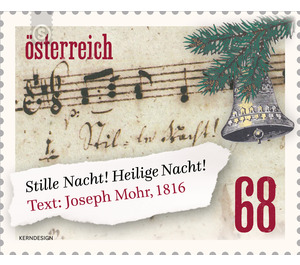Christmas - Austria / II. Republic of Austria 2016 - 68 Euro Cent
Theme: Religion & Spirituality
| Country | Austria / II. Republic of Austria |
| Issue Date | 2016 |
| Face Value | 68.00 |
| Edition Issued | 2,350,000 |
| Printing Type | offset |
| Stamp Type | Commemorative |
| Item Type | Stamp |
| Chronological Issue Number | 2641 |
| Chronological Chapter | OOS-OE2 |
| SID | 74768 |
| In 73 Wishlists | |
"Silent Night! Holy Night! "The most famous Christmas carol of the world originated in three small communities in the Salzburger Land. It was at Christmas 1818, when the auxiliary priest Joseph Mohr came to the teacher Franz Xaver Gruber and asked him to compose a melody to his eponymous poem. However, Mohr had not written this, as was long assumed, in 1818, but already in 1816, which is why at least the lyrics of the popular song 2016 are celebrating a milestone birthday. In 1816 Joseph Mohr was assistant priest in Mariapfarr in the Lungau, the community where the "Holde boy in curly hair" can be seen on the altarpiece of the church, which Mohr probably inspired as the famous line of his poem. Franz Xaver Gruber was again in 1818 in Arnsdorf as a teacher, in the local school building, he may have made his composition. Gruber himself described in the "authentic cause" preserved to this day how Mohr approached him on 24 December 1818 and asked him to compose a song for two solo voices, choir and guitars. That same evening Gruber went to work and played Mohr, who was himself a very musical person, then the song before. The two decided to have the premiere on the same night. When the Christmas song, so well known today, was first presented on Christmas Eve, it was Mohr and Gruber himself who sang the solo parts. For the birthday of the poem "Silent Night! Holy Night! ", A commemorative stamp now shows a section of a manuscript in the Salzburg Museum. It is not the original version of 1818, but the only preserved Silent Night autograph by Joseph Mohr. The autograph with text and melody is dated 1824 and simply bears the title "Weihnachtslied". The Christmas carol went all over the world, has been translated into numerous languages and is now an intangible cultural heritage of UNESCO.


